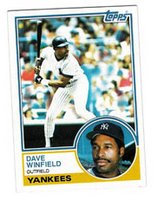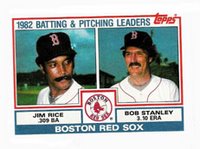 This set is generally considered to be the last year that Topps ruled the roost, and frankly, if I were Topps going into 1984, I would’ve thought you were crazy to think I wouldn’t beat Fleer and Donruss again: Fleer and Donruss were slow to gain their respective footholds in the hobby and while their 1983 sets were on the right track, they were nowhere near competing on Topps’ level. But change came and, in hindsight, Topps could’ve stayed competitive, but didn’t. Here's How Topps Done Wrong.
This set is generally considered to be the last year that Topps ruled the roost, and frankly, if I were Topps going into 1984, I would’ve thought you were crazy to think I wouldn’t beat Fleer and Donruss again: Fleer and Donruss were slow to gain their respective footholds in the hobby and while their 1983 sets were on the right track, they were nowhere near competing on Topps’ level. But change came and, in hindsight, Topps could’ve stayed competitive, but didn’t. Here's How Topps Done Wrong. Baseball cards are, by nature, self-reflexive. They are made to document, compile and provide a Who’s Who of baseball players, and their root purpose lies in statistics, both quantitative and qualitative: they are here to celebrate and record the past season’s triumphs and achievement. Every year players get older, their careers progress and younger players take their spots. All of this is obvious; something nobody has to think about.
 And really it’s this last point that truly makes 1983 Topps both fantastic and marks its own downfall from hobby leader: it’s a pageant of triumph and achievement, more consistently than any other set since 1974 (with the Hank Aaron Specials hero-worship subset). I’m talking, of course, about the Super Veterans card subset. They’re almost too self-reflexive. By 1984 Fleer and Donruss were firmly establishing themselves as rookie-driven sets, with Fleer’s hallmark Update set and Donruss’ introduction of the front-of-card-labeled Rated Rookie.
And really it’s this last point that truly makes 1983 Topps both fantastic and marks its own downfall from hobby leader: it’s a pageant of triumph and achievement, more consistently than any other set since 1974 (with the Hank Aaron Specials hero-worship subset). I’m talking, of course, about the Super Veterans card subset. They’re almost too self-reflexive. By 1984 Fleer and Donruss were firmly establishing themselves as rookie-driven sets, with Fleer’s hallmark Update set and Donruss’ introduction of the front-of-card-labeled Rated Rookie. Topps, in contrast, was not only doing the same thing it had always done, but it was also calling attention to the past, sometimes 20 or more years back. And while that may have worked for the collectors who bought the special 1952 reprint set the company put out, little kids and the average collector just weren’t interested in nostalgia (that would come 20 years down the road). So while it’s cool to think about how long Bruce Sutter played in the majors (and just how old his beard really is), it’s much less cool to get a Bruce Sutter Super Veteran, especially when your friends were getting Julio Franco rookies in their packs of 1983 Donruss.

This is not to say that 1983 Topps didn’t have rookies. Its checklist did, in fact, feature copious amounts of rookies (including Jim Eisenreich, the great epileptic star of the late-1980s Royals), with the Sandberg, Boggs and Gwynn rookies still holding up in value today (yes, I have my Tony Gwynn in a screwdown case, so, just in case I spill something on it, I can watch in horror and fumble for a screwdriver as the liquid slowly leaks through the plastic onto the card).
I would even go so far as to say that 1983 in general was one of the strongest years (checklist-wise) of the decade. Think about it: rookies of Hall of Famers Gwynn, Sandberg and Boggs (plus Frank Viola, Chili Davis and a late-season Darryl Strawberry (Topps Traded)); second years of Ripken, Bell, Lee Smith, Dave Stewart and Kent Hrbek, not to mention stars like Brett, Murray, Dawson, Molitor, Ryan, Yaz, Bench, Jackson, Rose, Schmidt, Fisk, Carlton, Yount, Winfield, Ozzie Smith and Gary Carter. Before Clemens, Gooden and Puckett came on the scene in 1984/5 and the Great Rookie Crop of ’86/7, this set had quite possibly the strongest checklist since 1976 Topps (though maybe 1979 is more like it).
But while it didn’t seem obvious (or noticeable) at the time that Topps was slipping, it is today. Even if we let Topps get away with the ‘Super Veterans’ of 1983, we have to hold them responsible for their answer in 1984 to Donruss’ Rated Rookie, the All-Time Active Leaders. How much older can you get?
 In 1984 Fleer ripped Topps off by releasing their own end-of-the-year traded set, but it was almost inevitable that it would happen sooner or later. So how did Topps compete with Fleer? By not including extended rookies (XRCs) of Clemens and Puckett. Topps must have been under evil management from a parallel dimension from 1979 to 1984, because it’s almost like they didn’t even try with rookies until the Team USA Olympic cards in the 1985 set. The only big, denoted rookies in that 5-year span (Pedro Guerrero, Fernando Valenzuela, Cal Ripken, Tim Raines, George Bell) seem to be flukes rather than the norm. It seems oddly fitting that the company that gave birth to the greatest rookie cards ever (both denoted and not) lost its grip on the hobby in the very same span of years that it left the rookie cup of the Topps All-Star Rookie on the shelf (before 1987 it was last used in 1978).
In 1984 Fleer ripped Topps off by releasing their own end-of-the-year traded set, but it was almost inevitable that it would happen sooner or later. So how did Topps compete with Fleer? By not including extended rookies (XRCs) of Clemens and Puckett. Topps must have been under evil management from a parallel dimension from 1979 to 1984, because it’s almost like they didn’t even try with rookies until the Team USA Olympic cards in the 1985 set. The only big, denoted rookies in that 5-year span (Pedro Guerrero, Fernando Valenzuela, Cal Ripken, Tim Raines, George Bell) seem to be flukes rather than the norm. It seems oddly fitting that the company that gave birth to the greatest rookie cards ever (both denoted and not) lost its grip on the hobby in the very same span of years that it left the rookie cup of the Topps All-Star Rookie on the shelf (before 1987 it was last used in 1978).
So that’s my version of How Topps Done Wrong. They did, however, get the design right: fluidly defined spaces (for the early 1980s), with a circular headshot harking both back to the 1963 base card design and ahead to the looser, more informal 1984 design (which never would’ve come about without the strictly separated 1983). The subsets are cool (especially the All-Stars) with Team Leaders leading the pack (really just a way to give guys like Bob Stanley more than one card).
 This is one of the most meaningful Topps sets of the decade and boasts one of the strongest checklists in years with Hall of Fame rookies, strong second-, third- and fourth-year stars and a Super Veterans subset that, once you get past how it metaphorically damaged the Topps standing as home of the rookie card and pushed the company to third out of three, is interesting—especially because it’s fun to see how many of the older stars had gained a significant amount of face fat over their careers (I’m thinking of you, Tony Perez).
This is one of the most meaningful Topps sets of the decade and boasts one of the strongest checklists in years with Hall of Fame rookies, strong second-, third- and fourth-year stars and a Super Veterans subset that, once you get past how it metaphorically damaged the Topps standing as home of the rookie card and pushed the company to third out of three, is interesting—especially because it’s fun to see how many of the older stars had gained a significant amount of face fat over their careers (I’m thinking of you, Tony Perez).

7 comments:
I think the two photos on one card idea that Topps used in 1983 and 1984 was a reaction to Fleer. If I remember right(and why I remember such things, who knows?), is that Fleer would boast during these years in their marketing materials that they had two photos on every card.
I actually think the Super Veterans subset was cool, but they could've done without players like Dave LaRoche and Bobby Murcer. Scaled it back somewhat.
And how was Bruce Sutter a Super Veteran in 1983? It would be like if they came out with that subset now and a having a rookie from 2000 being a Super Veteran.
Great stuff, as always. I'm eagerly anticipating the Top Seven.
One note: didn't Jim Eisenreich actually have Tourette's Syndrome, rather than epilepsy? Or maybe I'm remembering incorrectly.
Keep up the good work.
IIRC, Eisenreich has Tourette's not epilepsy. Ask the Fenway faithful.
"I would even go so far as to say that 1983 in general was one of the strongest years (checklist-wise) of the decade. Think about it: rookies of Hall of Famers Gwynn, Sandberg and Boggs (plus Frank Viola, Chili Davis and a late-season Darryl Strawberry (Topps Traded))"
I'm pretty sure Chili Davis' rookie was in the '82 set. It was a Future Stars card he shared with Bob Brenly and some other guy.
1983 topps - as the first set I ever collected - has a special place in my heart... I remember it came with some kind of baseball-themed scratch-and-win game card in each pack... any info on those?
My favorite Topps set of the 1980s, with the possible exception of 1981. The people at Topps really made a mistake when they stopped putting out league/team leader cards later in the 1980s. The 1983 set is a classic design. I must have bought dozens of packs of these back when I was 12 - the price was 35 cents a wax pack, if memory serves. I still have plenty of those scratch and win cards as well. I think you could win a trip to the 1984 All Star game. A number of Topps sets of that era featured similar in-pack promotions. I never won.
it was still the best Topps rookie card set since 1975:
http://dailysportscard.com/content/essential-collections-1983-topps-big-three-rookies
Post a Comment